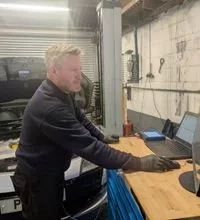Frank Massey: The rise of the oscilloscope
In this article: In the fourth and final part of his series, Massey explores the skills required to be a modern vehicle technician
History shows that personal vehicle ownership is a privilege, not a right. I believe that the future lies with a fully integrated public transport system operating in harmony with personal transport. This is made more likely by sharp increases in operating and ownership costs. Drivers will move to leasing and short-term rental over ownership. Such a shift will undoubtedly affect all sectors of our industry.
Technical developments have made things harder for technicians and I don't see a transition back to formal engineering skills taking place, despite them being essential for vehicle repair. This hits the nub of the issue: we are in an era of replacement not repair, prioritising symptoms over causes.
When I repair vehicles I want to know both what has gone wrong and why. This approach demands comprehensive knowledge, particularly individual component functionality within a system network. To achieve this I rely on two essential tools: the oscilloscope and the serial platform. Both have limitations, but the skill lies in knowing which is needed.
Call it intuition
Serial diagnostics has made an invaluable contribution in the repair of vehicles. However it has become a crutch for so many technicians, diminishing their intuition when approaching intractable problems. Data provided via this platform often can’t provide the amount of evidence needed for a technician to make a truly informed diagnosis.
The oscilloscope has revolutionised our industry more than any other tool. It demands a comprehensive knowledge of circuit and component functionality and thus, by default, a complete understanding of condition and cause.
Accuracy is key
You may think that oscilloscopes only provide electronic systems evaluation, but that isn’t incorrect.
It's imperative to view a circuit function in real time. This view should not be limited to voltage, it should include current, movement, pressure, temperature, and vibration. We also need to view multiple events to understand 'request and response' better.
The three basic functions of a scope are: acquisition (data collection), storage and display (viewing the data). Sensors provide data from which the powertrain control module (PCM) will apply a response from look-up tables. They also respond to environmental conditions, creating a situation where the PCM will predict a condition. This should be compared to actuator response with movement and current measurement.
These features have unique properties: frequency, duty, rise time, decay, peak value, induction response and movement ratio. All are essential to an accurate diagnostic process.
A very particular set of skills
We all need to understand some key disciplines, for example, measuring air mass meter response as a voltage or current, then comparing it against Lambda Bank 1 response or fuel rail pressure. This simple process enables a technician to accurately assess load request and fuelling response as a variable across load and engine speed.
Past frustrations with inaccurate, off-vehicle PCM testing directed me towards current analysis through inductors and actuators. Current profiles display rise time, peak value, and the all-important induction process.
My focus then shifted to mechanical skill sets such as internal engine efficiency. I replaced conventional compression testing with real-time in-cylinder pressure evaluation.
Given the complexity of vehicle systems, it's essential that the opinion of the technician is replaced with actual evidence-based data. The motor vehicle is, ultimately, a collection of components in conflict, so by stripping out the different frequencies and directions with a 3D accelerometer we can quickly isolate the cause of faults.
This series of articles has only just touched on the numerous facets of our incredible industry, and the key to becoming a successful and accomplished technician is to keep learning and improving your skillset.




